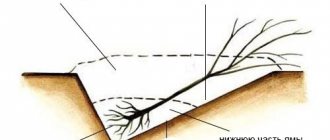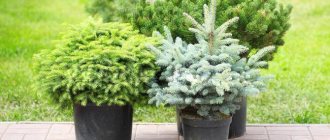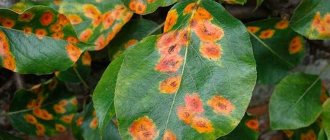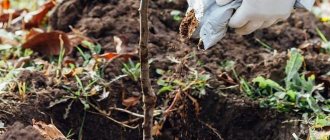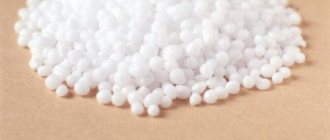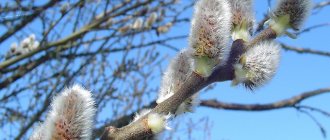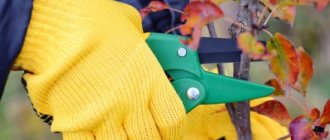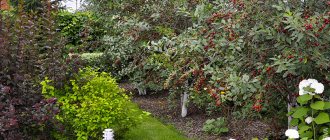Description
Columnar trees got their name because of the shape of the crown, which is similar to a column. When you see them for the first time, it may seem that the plant is devoid of branches and has only a trunk. But that's not true. These interesting trees still have shoots. They are just not large and approximately the same along the entire length of the barrel. Most often, side shoots are missing or cut short. The distance between neighboring buds is small. Flowering and fruit formation occurs on short branches. It feels like the fruit is growing right on the trunk. Seedlings of columnar plants have larger trunks than similar crops with a different type of crown.
Summer care
In the summer we continue to water, fertilize the plant and remove weeds. Drip irrigation is used without mulching. Or the soil is mulched and each tree is watered with buckets or a hose. In addition to watering, we shower the columns 2-3 times a month, washing its entire above-ground part.
In mid-summer we reduce watering, and in August we stop it completely. This allows the tree to prepare for winter and form flower buds for next year. In summer, we actively feed the trees, as this is the time of growth, flowering and fruit formation.
Suitable for this:
- complex fertilizers for trees;
- urea;
- cow manure or chicken droppings;
- ammonium nitrate.
Feeding a month after planting a young tree. Until mid-July, we apply fertilizer another 3-4 times.
From mid-summer, apple trees feed only on phosphorus and potassium. Nitrogen fertilizers cannot be used during this period. They will negatively affect the growth and development of fruits.
Even more information in the article - How to care for apple trees in the summer.
History of appearance
Columnar apple tree
The first mention of a columnar plant dates back to 1964. A Canadian farmer noticed an unusual shoot with dense and elastic wood on his fruit tree. A Mackintosh apple tree has grown a straight branch without side branches. The shoots on it were short, and at their ends there were large apples. The farmer turned to the breeder to show him an unusual plant. The specialist was impressed, and with the gardener’s permission, he began his research and experiments. The result of his work was the first specimen of an apple tree with a columnar crown, which was called “Vazhak”. Translated from Polish, this word means an elongated pole that is used for making hay. Later, the tree was brought from Canada to Europe, where breeding experiments continued.
Watering and fertilizing
One seedling requires approximately 2 liters of warm water, and needs to be fed 3 or even 4 times a year.
Watering should be done as the soil dries out. The main thing is not to overdo it - the roots may begin to rot and unripe fruits may fall off. If, after all, the apical bud has died, then it is necessary to remove all the shoots, except for the one that better supports the vertical position of the tree. Feeding schedule:
- The end of the first ten days of May.
- Then - after two weeks.
- The last one is in two weeks.
How to make fertilizer? Mix a tablespoon of ammonium nitrate or nitroammophoska and a shovel of humus (manure) in a bucket of water. It must be applied at the rate of approximately two liters for each seedling.
To improve soil fertility, we recommend adding the following minerals:
- Potassium – about 60 grams per tree;
- Superphosphate – 70 grams;
- Compost - approximately 15 kg per square meter;
- If the acidity of the soil is high, we recommend using dolomite flour - 100 grams per square meter.
Also, in the first years, in the absence of active rains, the plant requires intensive watering. The generally accepted procedure for applying fertilizers should not be neglected:
- Spring – nitrogen fertilizing.
- Then, in the middle of the growing season, fertilize with an NPK complex.
- Starting from July-August, organic and nitrogen fertilizers should be completely excluded from the mineral nutrition complex, and concentrate on potassium fertilizing.
- Due to the characteristics of columnar trees (planting density and abundant fruiting), it is necessary to apply about 10 kg of urea and 500 kg of manure per hundred square meters every autumn.
Keep an eye on the weeds. They greatly deplete the soil, which already has a hard time due to the “demanding” nature of the columns. The most important thing is to prevent the tree trunks from becoming overgrown with weeds. You cannot dig up the soil, this can damage the root system, so you will have to weed it manually. It will be enough to simply mow the grass between the rows.
Columnar trees: features and disadvantages
Among the advantages of columnar trees are the following:
Small size. This advantage is especially relevant for owners of small garden plots, where every centimeter of land is worth its weight in gold. On a modest plot of this type, trees can be planted in significant numbers. They will also be easy to harvest.
- A bountiful harvest. Columnar fruit trees are early ripening and bear fruit in the second year. For example, from one tree you can collect from 10 to 15 kg of apples.
- Does not require special care.
- Decorative properties. Low-growing fruit trees are particularly decorative. Densely flowering or fruit-bearing crops will decorate any garden plot.
There are also some disadvantages to columnar varieties:
- Fragility. Such trees bloom and bear fruit for no more than 20 years. Consequently, the garden will need to be updated quite frequently.
- The price for columnar seedlings is higher than for regular ones.
What are they, columnar fruit trees?
The cultivation of columnar varieties has a relatively short history.
In the middle of the last century, a Canadian farmer discovered a peculiarity in the arrangement of fruits on one of his apple trees. With an almost complete absence of side shoots, the branch showed good fruiting. Using breeding methods, based on this feature, varieties with a compact arrangement of branches and fruits were obtained. The height of such plants is no more than 250 cm. Their crown does not grow in width, and rarely exceeds 50 cm in diameter.
Columnar-shaped fruit trees allow you to quickly and easily harvest crops and organize a garden on almost any, even very small, plot.
Selection of seedlings
a) annual tree b) growth of fruit formations c) flowering d) fruiting
It is necessary to take a serious approach to the issue of choosing seedlings, since the quality of the harvest will depend on this. Before purchasing them, pay attention to several important details:
- color of the upper bud;
- shoot maturity;
- presence of leaves;
- root condition.
Saplings with mature shoots, in which the upper bud is green, there are no leaf blades, and the root system is elastic and devoid of dry, damaged branches, are suitable for planting. Before planting, seedlings must be properly cared for. They are placed in a cool place and the roots are kept constantly moist. To do this, the root system can be placed in a damp soft rag and, as it dries, moistened again with water.
Caring for a columnar apple tree after planting
Prepare the soil for planting in early spring. As soon as the ground thaws, add saltpeter, urea or suspension to it. Plant trees tightly, according to a pattern of 0.4 to 0.7 m in a row and 1 m between them.
The pits should be small - 0.9 m on each side. You have added the following fertilizers to the holes since the fall:
- ash – 450 grams;
- potassium – 70-80 grams;
- superphosphate – 80-100 grams;
- organic fertilizers and compost – 3-5 kg;
Bury the seedlings so that the root collar is 5 cm above ground level. After planting, water each tree with a couple of buckets of water. Mulch the soil with cut grass, peat or humus. Immediately after planting, the trees do not require further feeding.
Planting columnar trees
When choosing a place for planting, you must remember that columnar tree species do well in open, illuminated southern areas of the garden. They do not tolerate winds and drafts well. The land must be fertile. There should be no groundwater nearby. The composition of the soil is loose, so that there is good circulation of air and water. Loamy and sandy loam soil is suitable. Acidic soil is limed.
Spring is the most suitable time for planting seedlings. When planting an entire garden, it is necessary to maintain a distance of one meter between plants and rows.
The holes must be dug in advance to allow the soil to settle. When digging a hole, the size of the crop's root system must be taken into account. Usually a hole of 60 cm by 70 cm is sufficient. If you plan to plant an entire garden, then gardeners practice digging a trench.
A layer of drainage is poured into the recess, and potassium and phosphorus fertilizers are added one tablespoon at a time. After this, the young tree is placed. The root system is buried, carefully compacting the soil. Planting ends with watering and mulching.
How to plant, care for and prune columnar fruit trees
In order to get a harvest as soon as possible and not to lose a plantation of columnar seedlings due to errors in care, you should adhere to general recommendations that can be applied to all dwarf trees.
Columnar seedlings
Landing
Fruit trees for the garden
Experienced gardeners believe that it is best to plant young trees of columnar varieties in the first ten days of September. This will allow them to take root and overwinter so that they can actively begin to grow next year. You can also plant in the spring, if circumstances arise.
The optimal soil composition is loamy or sandy loam. Since the root system of trees of this type is quite weak, especially in young seedlings, everyone will need support. When planting rows, it is recommended to install a common extended support - a trellis or fence.
Planting pattern: 0.8-1 m x 1.2-1.5 m. A distance of 1.5 m between rows is sufficient for processing row spacing both manually and mechanized. A hole is dug 0.5 m deep. A bucket of water is poured onto its bottom. The excavated soil is mixed with two shovels of compost or rotted manure, and a tablespoon of phosphate and potash fertilizers is added. The seedling is lowered into the hole so that its roots are neatly straightened. Then sprinkle with soil and fertilizers. The bucket of water is poured out again. The stem is tied to a support.
Attention: the grafting point must be above ground level.
Care
In the first year after planting in the spring, all flowers on the trees are pinched. This is done so that the plant does not waste its energy, but directs it towards active growth and rooting. In the second or third year, the ovary is also monitored very closely. The fact is that all columnar varieties bloom very profusely and form bunches of 5-7 fruits on their short branches. It is advisable to thin them out, leaving only 2 each. This will allow the remaining fruits to truly ripen. Otherwise, the young tree will be depleted, and its fruits will be small and of poor quality.
The root system of columnar trees is located close to the soil surface. Therefore, they suffer from powerful weeds. To prevent this, you can choose any of the following strategies:
- Manually weed the garden regularly, as the use of hoes and mechanized cultivators is contraindicated.
- Grassing is the purposeful sowing of free soil around trees with low-growing cereal grasses, which enrich the soil with valuable nutrients and also prevent intense evaporation of moisture.
- Mulching - sprinkling the soil with shavings, sunflower or peanut husks, chopped grass, etc. The recommended thickness of the filling layer is 3-5 cm.
Not only treatments with insecticides and fungicides, but also the installation of trapping belts around trunks and hanging traps have proven themselves to be effective in pest control. The sticky substance will prevent ants from bringing aphids onto the leaves, and traps on the branches, which are containers filled with a mixture of sweet compote and sunflower oil, will become a place of death for many flying pests.
Attention! Traps for butterflies and beetles are installed only when the garden has faded and the fruits are green. This will eliminate the risk of bees dying.
Young plants need moisture, but it is important not to overdo it with watering. Recommended frequency: 1 time per month. In this case, drip irrigation systems can be used. In the first year, fertilizers are not used, and in subsequent years, irrigation water is mixed with organic fertilizers once a month.
Trimming
Although side branches are not typical for the colab-shaped variety, they may appear from time to time. This process can be triggered by freezing of the apical bud. If this really happened, then all the side branches are removed except one, which will replace the trunk in the future. In other cases, the lateral branches are completely removed.
The cut areas cannot be left just like that; they must be coated with garden varnish, since various pests and diseases can easily penetrate the wood through the damaged area. Pruning performs not only a formative, but also a rejuvenating function. In the spring, cut out all shoots that are weakened and frozen over the winter. Without waiting for the side shoots formed in the summer to gain strength, they are carefully pinched. In autumn, the main trunk is shortened slightly, and the crown that is too thick is thinned out.
Pruning columnar fruit trees
Care
Caring for a columnar garden comes down to watering and fertilizing. There is practically no need to prune the branches, since many varieties do not grow side shoots at all.
Young trees will only need watering for the first few years. Then their root system will strengthen, grow, and the trees themselves will provide themselves with the necessary moisture. Water the plants around the trunk. When watering in the usual way, the ground must be mulched with straw. In dry summers, the crop is watered once a week. In rainy weather, additional moisture is not required. It is good to sprinkle fruit trees periodically. This will not only moisturize the plants, but will clean their leaves of dust.
Heavy fruiting of trees leads to rapid depletion of the soil and therefore it needs additional feeding. Columnar fruit trees are fertilized in several stages. The first fertilizing with urea or saltpeter is done in the spring, when the snow melts. The following fertilizers are applied during flowering and a week after it. During these periods, cow dung diluted in water mixed with wood ash is used. The last time the trees are fed is in the fall with potassium and phosphorus fertilizers.
When lateral branches appear, pruning of columnar trees is still necessary. The cut areas are treated with garden varnish or other specialized means. In the spring, when inspecting trees after cold weather, you need to pay attention to the top bud. If a weak shoot grows from it, and another one forms nearby, then you should wait until they both grow back and save the stronger one.
Video “Is it possible to prune a columnar apple tree”
It is also necessary to normalize the number of colors. In the first year, it is recommended to remove all inflorescences. In the second year, thinning occurs in three stages. The first stage is at the stage of bud formation, when every second of them is removed. The second stage occurs during the appearance of the ovaries. There should be twice as many of them left on the tree as the desired harvest. The third stage - the fruits are left for harvesting.
To avoid disturbing the weak root system, cereal crops or dill are sown under the plants, which are carefully mowed as they grow.
Like any fruit trees, colony trees can be susceptible to pests. If they are detected, it is necessary to treat the crops with insecticides intended for fruit trees.
How to plant a columnar apple tree?
Columnar apple trees, like other fruit trees, are planted in spring or autumn. When choosing a planting time, gardeners take into account local climatic conditions. For example, in regions with harsh winters, it is safer to plant in the spring.
Optimal timing
When to plant seedlings:
- In the spring. Planting is done before the buds open. In central Russia, suitable conditions occur in the second half of April. In the Urals and Siberia a couple of weeks later.
- In autumn. In the middle zone, seedlings are planted in late September-early October. In more northern regions, planting begins a little earlier. The starting point for work is the fall of leaves. There should be 25-30 days left before frost.
When planting trees in spring or autumn, you cannot focus only on calendar dates; you must make allowances for meteorological conditions.
When planting seedlings of columnar apple trees, preference is given to the spring season.
Autumn planting
Columnar apple trees are best planted in rows. The optimal distance between neighboring seedlings is 0.5 m. Row spacing is 1 m.
Autumn planting order:
- A couple of weeks before planting, dig holes for planting with a depth and diameter of 90 cm. This will prevent soil settlement after planting the seedling and the root collar from burying into the ground.
- When digging a hole, fold the top layer of soil separately - it will be needed to create a soil mixture. Do not allow it to mix with infertile soil from the depths.
- If the soil is heavy or clayey, provide drainage to prevent root rot. To do this, place broken crushed stone mixed with sand at the bottom of the hole. The thickness of the drainage layer is 10-15 cm.
- Mix the fertile layer of soil obtained by digging a hole with 3-4 buckets of humus or compost. Add 100 g of potash fertilizers and superphosphate, and add a glass of dolomite flour for deoxidation.
- Pour half of the resulting soil mixture into the hole. Level it and leave it for two weeks to allow the soil to shrink and compact.
- Half a month after digging the hole, start planting. Start pouring the rest of the soil mixture into the hole. Do not level the resulting “hill” - you will place the roots of the seedling on its top.
- Place the apple tree so that the roots are evenly distributed on the earthen mound, and the grafting site is above ground level - you cannot bury it.
- Fill the hole with infertile soil that was removed during digging. Compact the soil.
- Stepping back 0.3 m from the trunk, make an earthen rampart 10-15 cm high around the perimeter - it will prevent water from flowing out during irrigation.
- Water the seedling with 1-2 buckets of settled water.
- When the water is absorbed into the soil, sprinkle the tree trunk circle with mulch - sawdust, peat or chopped grass.
If there are doubts about the strength of the seedling, or there is a risk of strong winds, install a support next to it. Tie the tree with soft material - rope or twine.
Spring planting
The technology for spring planting is practically no different from autumn planting. The main feature is the timing of pit preparation. It has been prepared since autumn. Over the winter, the soil will settle well, become compacted, and fertilizers will dissolve and be absorbed into the soil.
Preparing the hole in the fall allows apple trees planted in the spring to quickly take root, since during the winter the planting site turns out to be ideally prepared to receive the seedling. Apple trees planted in an “autumn” hole often bloom in the same spring.
Popular varieties
Columnar apple tree
Among the varieties of columnar fruit trees, the following can be distinguished:
- "Carmen" is a variety of pears with large burgundy fruits. Ripening occurs in the summer.
- "Sapphira" - refers to the autumn varieties of pears. The fruits reach medium size and have a yellow-green color.
- "Decor" is a variety of pears that ripen by early autumn. The fruits are sand-colored and small in size.
- “Malyukha” is an apple tree with small yellow fruits. They taste very sweet.
- “Currency” - this variety of apples has medium-sized fruits, ripen late and have a slight sour taste.
- “Medoc” is a variety of apple tree with medium-sized fruits that have a characteristic sweet taste. Ripening occurs by mid-summer. The variety tolerates winter cold well.
- "President" is one of the early varieties of apples. Has good winter hardiness. The fruits are green in color and reach medium size.
- "Blue Sweet" is a plum tree up to two meters high with large purple fruits weighing up to 70 grams.
- "Mirabelle" is a rare variety of plum variety with yellow, late-ripening fruits.
Thus, columnar trees are an excellent solution for small garden plots whose owners want to get a varied, rich harvest of fruit.
Diseases and pests
Most gardeners begin pest control with prevention. The main pests of the columnar apple tree are aphids, moths and mites. Common crop diseases are scab, powdery mildew and leaf rust.
As a preventive measure, spray trees with insecticides and fungicides in the spring. Most pests are insects, almost all diseases are caused by fungi.
The most popular fungicides include the following:
- Horus,
- Planriz,
- Fitolavin.
In this case, each fungicide is used to kill a specific type of fungus that causes disease.
The most effective remedy for destroying several mushrooms at once is Bordeaux mixture. Insecticides:
- Admiral,
- Aktara,
- Aktellik,
- Karbofos,
- Phosphamide.
Basic rules for the use of drugs against apple tree pests
Aphid . In the spring, before buds open, the apple tree is treated with a 3% Karbofos solution. If the buds have already bloomed, use a 2% solution of the same drug. You can use its analogues: Fitoverm, Phosfamide, Aktara.
Mol . Its caterpillars quickly and efficiently destroy fruits and spoil shoots. The moth is similar to the mole, has the same color and size. After flowering, the tree is sprayed with chlorophos or metaphos. After 15 days, treatment must be repeated.
Mite.
It feeds on young apple tree leaves. Leaves behind a trail of barely noticeable cobwebs. Treat against parasites with Nitrafen or Olicupurit before the buds open. During the budding period, use Karbofos and Phosfamide. In extreme cases, a third treatment with an analogue can be carried out.
When treating an apple tree for mites, use various means. This prevents the parasite from developing immunity.
Remember that you cannot process trees in strong winds. This is harmful for the apple tree and humans.
Fighting columnar apple diseases
Scab . A fungal disease that affects leaves, flowers, fruits and tree shoots. Favorable conditions for the development of fungus are high air humidity. A sign of scab is greasy spots on lettuce leaves. Then they become covered with a brownish coating.
Treat the tree and surrounding soil with 4% Bordeaux mixture at the rate of 200 g per 5 liters of water. You need to have time before the buds open. If you are late, spray the apple tree during budding with 1% Bordeaux mixture. Re-treat the plant immediately after flowering. Any targeted fungicide will do.
The third treatment is three weeks after the second. We recommend using different fungicides to achieve the best effect. In case of severe scab infestation, up to 6 fungicide treatments per year are allowed.
Powdery mildew.
The disease affects the leaves, bark, shoots and buds of the plant. The entire tree can become infected. The apple tree grows and bears fruit worse. Start processing before the leaves appear. Spray with 1% Bordeaux mixture or topaz at the rate of 2 ml per bucket of water. Treat the second time after flowering with copper oxychloride at the rate of 40 g per 5 liters of water.
Leaf rust . Rust spots form on the leaves. Gradually they cover the entire leaf blade. The leaves fall early, and the winter hardiness of the apple tree decreases. You can take any fungicides that describe treating rust.
Remember, chemicals often kill both pests and beneficial insects. Therefore, use non-chemical products first.
In early spring, you can use horticultural oil to control dormant insects and their eggs. Spray the tree before new leaves appear.
Columnar garden: pros and cons, growing columnar trees
When planting any fruit or ornamental plantings, you can choose not only certain crops, but also plants with different crown shapes. The crown should be understood as the totality of all branches from the first branch on the main trunk of the plant to its top. Most often you can find trees with crowns:
- spreading
- pyramidal, with sharp apexes
- narrow pyramidal
- columnar
- weeping
Let's consider the question of what a columnar crown is and what advantages a columnar garden has.
Columnar shape, pros and cons of columnar gardens
For the first time, attention was paid to the apple tree with an unusual crown in Canada. This happened around the middle of the last century.
Perhaps as a result of an unknown natural mutation, one of the branches of the tree was dotted with numerous fruiting branches on which apples were located.
Sometimes, at first glance at a tree with a columnar crown, it may seem that it has no branches at all and consists of one trunk.
However, it is not. These trees still have a crown. Its width is approximately the same throughout. The columnar form most often either does not have lateral branches, or they are cut quite short. Flowers and fruits on columnar plants are formed on numerous shortened shoots - ringlets or on spears that end in a bud.
With such a crown, it will seem that the flowers and fruits are located directly on the trunk. A distinctive feature of columnar crown ringlets is shortened internodes - the distances between neighboring buds. Young seedlings have trunks that look much thicker than related plants of the same age. In addition, they should completely lack side branches.
The advantage of a columnar crown is its compactness. As a result, you can increase the number of plants on the site. This is convenient when the plot is of modest size.
Since columnar trees have rather modest growth rates, they rarely reach large sizes. This makes gardening easier, including harvesting.
Columnar forms are characterized by early ripening; they can produce a harvest in the second year.
In addition, gardens consisting of columnar trees are highly decorative. This allows them to be used in landscape design, when designing alleys and paths.
A significant disadvantage of a colony garden is its fragility. Most often, the lifespan of such plants rarely exceeds 15–20 years.
In addition, if there is no skill and experience in caring for columnar trees, they can quickly lose their shape.
This is also possible when purchasing a seedling from an unscrupulous seller, when the plant only looks columnar.
It is also important to take into account that the plant should be grafted only onto dwarf rootstocks, otherwise neither flowering nor fruiting may occur for a very long time.
Also, columnar gardens with intensive fruiting greatly deplete the garden soil, which requires additional enrichment with fertilizers.
Since the first columnar plant to gain popularity was the apple tree, let us consider the conditions for planting and growing in the garden using its example.
Columnar apple tree, planting
As mentioned above, the history of columnar apple trees began in Canada. For the first time, an unusual branch was discovered on a McIntosh apple tree.
The plant was already 50 years old when the owner noticed a strange fruit-bearing branch. When material for grafting was prepared from the plant, all grafted specimens looked the same.
It is important to note that true columnar apple trees retain their shape with virtually no human intervention.
In the absence of powerful side branches, they require almost no pruning; their trunks are literally strewn with ringlets. The timing of the appearance of the first apples depends on the type of rootstock.
In one case, fruiting is possible even in the first year, in another – in the second year. In the next 7–8 years, the yield of columnar apple trees only increases. After this, it remains at the same level for another 5–6 years.
The total lifespan of columnar apple trees is 15–17, sometimes 20 years.
A decrease in yield may be associated with the death of ringlets. They do not recover on columnar apple trees. Pruning, which stimulates the growth of new ringlets, does not give results here. In the most favorable scenario, new growths may appear on the topmost tier, while the trunk will remain bare. In the southern regions, columnar apple trees of English selection can be recommended for growing:
- Trident is an early winter variety, the most densely fruiting, in the first year produces up to 1 kg of fruit, an adult tree produces at least 4 kg of apples, fruits weighing 100-120 g, conical shape, yellow-green color, red blush over the entire area of the fruit
- Taskan - apples weighing 160 - 180 g, round in shape, slightly flattened, yellow-green in color with a pink blush on the sunny side
- Teleimon - autumn variety, apples are round, with slight ribbing, weighing 150 - 190 g, main color green, red blush
All of these varieties have high disease resistance, but low winter hardiness. Among the domestic varieties, we can note the popular columnar apple trees:
- Currency
- The president
- Dialogue
- Ostankino
- Arbat
The above varieties have the columnar gene and are grown on dwarf rootstocks. This is how they fundamentally differ from ordinary varieties, which are grafted onto super-dwarf rootstocks and subsequently shaped by column-type pruning. Despite the fact that in addition to apple trees, other garden crops with a similar crown shape have appeared, let us consider planting and caring for them using apple trees as an example.
Planting and caring for trees in a columnar garden
For columnar plants, including apple trees, choose places with good sunlight, fertile soil and far-flung groundwater.
In terms of mechanical composition, loamy and sandy loamy loose soils with good water and air permeability are suitable. The best time for planting is spring, after the soil has completely thawed.
Seedlings in containers can be planted throughout the season.
The distance between plants is 0.9 - 1.0 m, between rows - 1.0 - 1.2 m. The planting hole must correspond to the root system. Most often, 0.6 by 0.7 m is enough. A tablespoon of potassium and phosphate fertilizers is added to the bottom of the pit. They install the seedling, cover the roots with soil, compacting it very carefully. Water the seedling well.
Some techniques for caring for columnar plants
Many people mistakenly believe that colony forms do not have powerful lateral branches. Such branches still appear. Usually there are 2 - 3, but there can be 10 - 12. Such branches are cut by treating the cut points with a special garden varnish or other specialized mixture. Regulating the number of flowers and fruits is a very important point. In the first year, it is advisable to completely remove all buds.
In the second year, flower bouquets are thinned out in several stages. The first thinning is carried out at the bud stage, removing every second bouquet; then the bouquets with the ovary are thinned out. There should be approximately twice as many ovaries left on the tree as the desired number of fruits. During the last thinning, only one of the two fruits is left.
Tinning and watering
Many columnar garden plants grafted onto dwarf rootstocks have very tiny and delicate roots. They can be harmed even by simply lightly trampling the ground under a tree. To avoid this, either cereals are sown under the trees, which are carefully mowed, or spicy herbs such as dill, which are cut off as they grow. In extreme cases, mulching can be used.
Columnar plants are watered either drip-wise, or after regular watering the tree trunk space is mulched with straw. Such plants also respond well to regular showers. Currently, not only apple trees, but also other crops are grown in columnar gardens:
To start growing a columnar garden, you can first plant several specimens of such crops.
about columnar trees in the garden:
Source: https://OgorodSadovod.com/entry/2873-kolonovidnyi-sad-plyusy-i-minusy-vyrashchivanie-kolonovidnykh-derevev
Features of dwarf varieties
Externally, the columnar tree, of course, looks quite exotic: a very straight trunk, from which many short side shoots extend at an acute angle. By autumn, apple and pear trees are covered with fruits, and the tree, indeed, strongly resembles a column - its smooth trunk is densely strewn with large fruits.
If you come closer to the columnar apple tree, you can see that it is an ordinary fruit tree. Apples look like regular fruits, and they taste just as juicy and sweet.
Attention! People first started talking about columnar trees in the second half of the last century. And they were brought out completely by accident, when one of the Canadian gardeners noticed a strange branch on his old apple tree: there were no horizontal shoots on it, but the entire branch was strewn with large apples.
Gradually, columnar fruits began to spread throughout the world, gaining more and more popularity every year. Today, many gardeners prefer this particular type of tree, because they have many advantages.
Advantages and disadvantages
The main explanation for the popularity of columnar varieties is their greater profitability: compared to traditional gardens, dwarf gardens benefit not only in terms of yield, but they are much more convenient to care for.
Columnar fruit trees have many advantages:
- miniature size of the crown and root system, allowing you to grow different fruits in small areas;
- minimum intervals between neighboring trees, allowing about 2,000 columnar fruit trees to be grown on a hectare of land versus 400 traditional ones;
- the small height of the tree (up to 2.5 meters) greatly simplifies garden care and harvesting;
- columnar varieties do not need extensive pruning - the gardener will only have to maintain the shape of the crown;
- early fruiting - the gardener will receive the first full harvest in the second year after planting the seedlings (ordinary varieties bear fruit in 4-5 years at best);
- saving on chemicals for treating a columnar garden - for a compact crown you will need very little product.
It turns out that with the same area of the orchard, the yield of columnar trees will be higher. In addition, the farmer’s costs for chemicals, pruning, and fruit picking will be significantly reduced. Another advantage is that the wait for the first harvest will not be long - only 1-2 years.
Important! The most important disadvantage of columnar fruit crops is their short life.
The short lifespan (12-15 years) of such trees is due to their rapid depletion, because with small dimensions, columnar varieties bear fruit on a par with ordinary and tall crops. After a specified period of time, most of the ringlets on the tree die off, resulting in a sharp decrease in yield. The gardener will have to uproot old plants and plant new columnar seedlings.
Varieties of dwarf crops
Columnar trees are used not only for producing fresh fruits and vegetables; they are actively used in their work by landscape designers. Miniature trees with an elongated cylindrical or cone-shaped crown look very original, so they can decorate any exterior.
All columnar plants today are divided into three large groups:
- Fruit (or fruit).
- Deciduous.
- Conifers.
In turn, columnar fruit varieties are divided into two more types: seeded dwarf trees and grafted dwarfs. Seeds are distinguished by the presence of a special gene responsible for the restrained growth of the plant (dwarf gene). Such fruit trees can be grown from seeds in the usual way. Grafted dwarfs are propagated from mother branches of columnar plants, which are grafted onto the root system of an ordinary related tree.
Advice! For apple trees of grafted dwarf varieties, it is recommended to use low-growing apple trees as a rootstock. But columnar pears are best grown on a rootstock of serviceberry or quince.
Correct fit
- The first step is to properly prepare the soil .
To do this, a pre-dug hole must be treated with a fertile substrate. Organic fertilizers or compost are ideal for these purposes, which can either be purchased at a specialized store or made with your own hands using leftover products. Also, shortly before planting a tree, it is best to also carry mineral fertilizers, which will saturate the soil with all the necessary microelements. It is important to know: it is strictly forbidden to apply mineral fertilizers directly at the time of planting, as they negatively affect the development of the root system. - After planting, the soil is watered generously . Remember, be careful not to overwater the tree; excess moisture may have a negative impact on it.
- Also, after planting, it needs to be protected from pests , since it is impossible to whiten it, it is best to carry out a detailed inspection and spray the crown of the plant in time.



